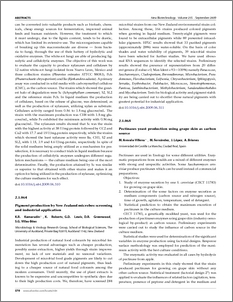Kamarudin, Kamarul Rahim and Roberts, Kelly and Lewis, Gillian and Greenwood, Dave and Villas-Bôas, Silas
(2009)
Pigment production by New Zealand microbes: screening and industrial application.
New Biotechnology, 25 (Supp).
S70.
ISSN 1871-6784
![[img]](http://irep.iium.edu.my/style/images/fileicons/application_pdf.png)  Preview |
|
PDF (Pigment production by New Zealand microbes: Screening and industrial application)
- Published Version
Download (76kB)
| Preview
|
Abstract
Industrial production of natural food colorants by microbial fermentation has several advantages such as cheaper production, possibly easier extraction, higher yields through strain improvement, no lack of raw materials and no seasonal variations. Development of microbial food grade pigments are likely to cut down the high production cost of natural pigments, thus leading to a cheaper source of natural food colorants among the modern consumers. Until recently, the use of plant extracts is known to be expensive and uncompetitive to synthetic dyes due to their high production costs. We, therefore, have screened 284 microbial strains from our New Zealand environmental strain collection. Among those, 166 strains produced colored pigments when growing in liquid medium. Twenty-eight pigments were found to be extracellular pigments while 89 presented intracellular pigments. HPLC results showed that 33 purified pigments (approximately 28%) were water-soluble. On the basis of color shades and water solubility of pigments, 39 microbial strains have been selected for further studies. We have used ribosomal RNA sequences to identify the selected strains. Preliminary results showed the presence of representatives from 20 different
genera (E-value = 0, Max Ident = 93—100%) namely Paracoccus,
Saccharomyces, Cladosporium, Brevundimonas, Microbacterium, Pseudomonas, Flavobacterium, Leifsonia, Chryseobacterium, Sphingopyxis, Serratia, Erythrobacter, Pedobacter, Micrococcus, Stenotrophomonas, Pantoea, Janthinobacterium, Methylobacterium, Sandarakinorhabdus and Mycobacterium. Tests for biological activity and pigment stability are being carried out to shortlist those natural pigments with
greatest potential for industrial application.
Actions (login required)
 |
View Item |


 Download Statistics
Download Statistics Download Statistics
Download Statistics